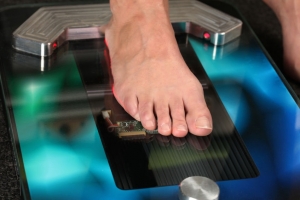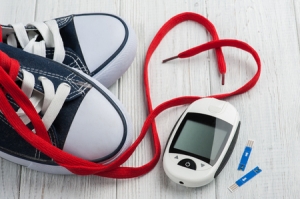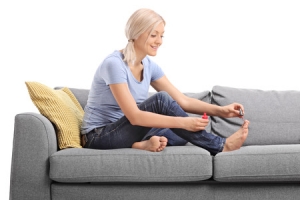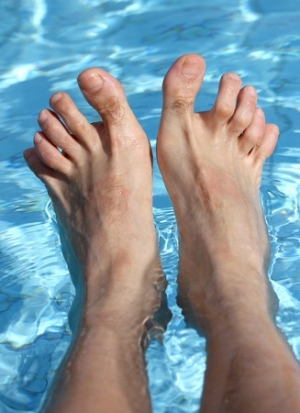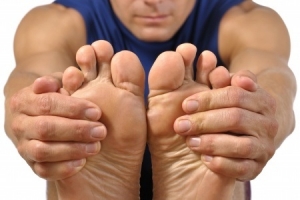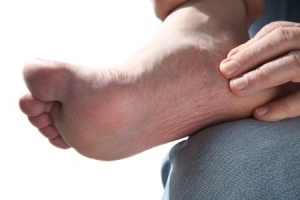Connect With Us
Blogs
Displaying items by tag: corns
FAQ’s about Custom Orthotics
At Superior Foot & Ankle Care Center we often get questions from our Los Angeles County patients about custom orthotics. Below are some of the most frequently asked questions about this very effective, non-invasive type of podiatric treatment.
Q: What conditions can orthotics help treat?
A: Orthotics are footwear inserts that are used to provide support and reduce pain, discomfort, pressure or imbalance, and other symptoms caused by a wide range of foot and ankle deformities, injuries, and diseases as well as biomechanical problems. Some common conditions that can be treated with orthotics include flat feet, heel pain, arthritis, bunions, calluses, corns, big toe pain, and neuropathic ulcerations.
Q: What’s the difference between over-the-counter shoe inserts and custom orthotics?
A: Over-the-counter inserts can provide some arch support and treat minor discomfort and pain. Prescription orthotics, however, are made from a mold of your unique foot and therefore better able to address and correct your specific foot issues. Prescription orthotics are also constructed of more durable materials and can last a long time.
Q: What are some common kinds of prescription orthotics?
A: Orthotics come in many shapes and sizes and are made from a variety of materials depending on individual needs. They may take the form of insoles, arch supports, heel pads, or foot cushions. Generally, there are two classifications of orthotics. Accommodative orthotics offer cushioning and reduce pressure on a vulnerable area of the foot. Functional orthotics are used to treat foot problems caused by foot and ankle motion and alignment.
Q: How are custom orthotics made?
A: The first step is to have our podiatrists, Dr. Victoria M. Foley and Dr. Constance Ornelas, conduct a thorough examination of your feet and ankles and evaluate how they are impacting your knees, legs, and lower back. Once the foot doctor has a diagnosis of your podiatric disorder and a complete understanding of the biomechanics of your foot, a mold of your foot will be made from a plaster cast or a specialized computer scan that maps your foot structure and your gait. The podiatrist will then check to make sure the orthotic is fitted properly and monitor your progress.
If you would like to learn more about orthotics and whether or not they can help you, contact our Long Beach office at (562) 420-9800 office for an appointment today.
Corns and Calluses on Your Feet
At Superior Foot & Ankle Care Center some of the problems our Los Angeles County patients bring to us most frequently are caused by repetitive friction and pressure being applied to the feet. Below are two common podiatric conditions of this type and what’s behind them.
Corns—typically corns appear on the tops and sides of the toes or between toes. They are the result of pressure from footwear or toes on toes and are often a secondary condition that develops as the result of a deformity such as a bunion, hammertoe, or claw toe. The deformity makes it difficult to fit into shoes and the constant pressure to a spot that is out of place or enlarged causes the corn to form.
Calluses—calluses are thickened patches of skin that are hard and tough. Although the problem manifests on the surface of your skin, the source is usually much deeper in the foot. Calluses are the result of long-term pressure to a specific spot, and they most often develop on weight-bearing parts of the foot like the heel, sole, ball of the foot, or big toe. Since the issue with a callus is more than skin deep, there may be inflamed nerves or bone deformity involved as well.
Treatment Options
Both corns and calluses can be treated at home by soaking them in warm, soapy water and then using a pumice stone or foot file to gently smooth and reduce them. Apply a rich moisturizer afterward to keep the skin soft. However, the best course of treatment is to consult our podiatrists, Dr. Victoria M. Foley and Dr. Constance Ornelas, to determine the root cause of your corn or callus. It’s unlikely that the problem will be resolved completely until the underlying cause of the friction or pressure is identified and treated.
If corns or calluses are causing you pain and making it difficult to find comfortable shoes, contact our Long Beach office at (562) 420-9800 for an appointment at your earliest convenience.
6 Tips for Protecting Your Feet with Diabetes
At Superior Foot & Ankle Care Center, we know that diabetes can affect your skin, joints, and bones in a number of ways. Two conditions associated with the disease—peripheral arterial disease (PAD) and neuropathy—are of particular concern when it comes to your lower extremities. PAD is a narrowing or blocking of the arteries to your legs, which can lead to poor circulation. This means that nutrient and oxygen-rich blood necessary for healing cannot reach your legs, feet, and toes as quickly as needed. Neuropathy is nerve damage that can result in loss of feeling in your feet, which makes it difficult to perceive pain and injury. This double whammy means that patients with diabetes are at a higher risk for a host of podiatric problems, including:
- Ulcers and wounds that do not heal properly
- Fungal infections
- Hammertoes
- Ingrown toenails
- Corns and calluses
Difficulty healing can cause even minor foot and toe problems to become major threats with the potential for infection and even amputation. Below are some ways you can be proactive in preventing foot problems if you have diabetes:
- Control your blood sugar. Follow all your doctor’s instructions for managing your diabetes. Watch your diet, take your medications as directed and regularly test to make sure you are on track.
- Schedule regular podiatric checkups. Our podiatrists, Victoria M. Foley or Dr. Constance Ornelas, will work with you to prevent potentially dangerous foot issues. Seeing the foot doctor regularly will increase the chances of catching injuries and infections in their very early and most treatable stages. The podiatrist can also help with nail care, wound debridement and diabetic footwear and orthotics.
- Keep feet clean, warm, and dry. Wash daily and dry thoroughly—especially between your toes. Use a foot powder before putting on socks.
- Make sure shoes fit correctly. Avoid styles that have narrow toe boxes are that are made of very stiff materials. Keep the heel height to 2 inches or less.
- Don’t walk barefoot. This dramatically increases your chances of getting athlete’s foot or a fungal toenail infection, which are contracted by direct contact. You are also more likely to step on a sharp object and injure your foot without shoes.
- Conduct regular self-exams—it’s important that between appointments you are checking your feet and toes daily for any signs of rashes, cuts, blisters, bruises, growths or other indicators that a foot problem is developing. If you can’t see your whole foot as a family member or caregiver to assist you. Contact our Long Beach office immediately by calling (562) 420-9800 if you find anything concerning.
A Beautiful Pedicure in 8 Easy Steps
At Superior Foot & Ankle Care Center we know that many of our patients enjoy getting professional pedicures but recent stories in the news about fungal and bacterial infections lurking at some salons may leave you feeling hesitant. If you don’t have a salon you trust to follow proper sanitizing procedures, we want you to know that you can give yourself a relaxing and pretty pedicure at home. Here’s how:
- First remove any old nail polish using cotton balls and nail polish remover.
- Fill a small tub with warm, soapy water and soak your feet for 5-10 minutes. Use a nail brush to gently scrub toenails and then rinse feet with clear water and dry.
- Rub a pumice stone or foot file on rough areas of the foot such as the heel and ball. This will exfoliate dead skin and help smooth calluses. If you have large or deep calluses or corns, make an appointment at our Long Beach office and let our podiatrists, Victoria M. Foley or Dr. Constance Ornelas safely remove or trim them.
- Trim toenails straight across and not too short. File the edges with an emery board. Do not curve the edges downward as this can lead to ingrown toenails.
- Gently push back your cuticles with an orange stick. Cuticles that extend from the nail margins can be trimmed using a cuticle trimmer. Do not cut so close that they bleed.
- Apply moisturizer to the cuticles and then the rest of your feet. Give yourself a soothing foot massage, using your fist to rub the balls of your feet and heel. Massage the top of your foot and your toes as well. You can also roll your feet on a bottle or rolling pin.
- Remove excess lotion from toenails with nail polish remover.
Brush on a base coat, then two coats of your favorite color and a top coat. Put your feet up and allow time for nails to dry completely. Enjoy!
Free Your Feet from Shoes that Hurt
Freedom is a word frequently associated with Independence Day and here at Superior Foot & Ankle Care Center, it’s also a reminder that many patients are wearing shoes that too small for their feet. Improperly fitting shoes is one of the top causes of foot pain and can lead to chronic foot disorders such as plantar fasciitis and fallen arches. Follow the tips below on your next shoe shopping trip to ensure a good fit:
- Don’t buy shoes without trying them on. Even if you think you know your size, fit can vary based on the manufacturer and the shoe style.
- Get your foot professionally measured. There are two good reasons for this. First, most people have two different sized feet. You’ll want to buy shoes to fit the bigger foot. Also, your shoe size may increase as you get older or if you’ve recently given birth.
- Shop at the end of the day. Your feet are at their largest and most swollen after you’ve been on them all day. A common foot shopping faux pas is buying shoes early in the day and then finding when you wear them that you can’t wait to take them off at the end of the day because they make your feet hurt.
- Focus on the toes. Many common toe problems such as bunions, hammertoes, ingrown toenails, and corns are made worse by shoes that have narrow toe boxes. High heels can also force toes into a cramped position. You should be able to wiggle all your toes freely in a properly fitting pair of shoes and there should be at least a half an inch of space between your longest toe and the front of the shoe.
- Avoid styles that are completely flat with no arch support. In addition, if the foot doctor has prescribed an orthotic device, bring it with you and try on with the shoes you are considering.
- Try on both shoes and take your time walking around the store to make sure they are comfortable. When you take the shoes off, check for red marks on your feet which may indicate friction or rubbing from the shoe.
If you are experiencing chronic foot aches and pains, schedule an appointment at our Long Beach office by calling: (562) 420-9800. Our podiatrists, Dr. Victoria Foley or Dr. Constance Omelas will evaluate your feet and determine whether it’s your shoes or another problem that is causing your discomfort.
Myths about Hammertoes
At Superior Foot & Ankle Care Center we often find that patients have no trouble identifying a hammertoe—its telltale downward bent at the joint makes it fairly obvious—but often that’s where the knowledge stops. Too often patients suffer for a long time with a hammertoe because they do not fully understand the condition and their treatment options. Below some common myths about hammertoes are dispelled to help patients be more informed about this condition:
MYTH: Hammertoes are caused by shoes that are too tight.
TRUTH: It’s true that improperly fitting shoes can contribute to or exacerbate the condition of hammertoe but usually a muscle/tendon imbalance predisposes the toe to bend downward. In some cases, one toe is longer than the others and pushes up against the front of the shoe. Hammertoe can also be genetic, the result of arthritis or a neurological or structural issue.
MYTH: It’s possible that over time hammertoes will get better without treatment.
TRUTH: Hammertoes are a progressive condition. Although they may progress at varying rates they will not improve and will, in fact, worsen to the point of being disabling if not treated. It’s important to have one of our podiatrists, Dr. Victoria Foley and Dr. Constance Omelas examine your hammertoe to assess how far it has progressed. The foot doctor may order x-rays to get a better look at the current state of the joint and will also want to get a complete medical history. Hammertoes should be monitored by the podiatrist.
MYTH: There’s no real treatment for hammertoes.
TRUTH: Actually there are several conservative options available to the foot doctor to help decrease pain, increase comfort and slow the progression of a hammertoe. These include: strapping or taping the toe to establish realignment, using a custom orthotic device to correct or compensate for a muscle tendon imbalance and doing stretching and other exercises to increase flexibility and strengthen supporting muscles. In addition, patients should choose shoes with low heels that have roomy toe boxes and are made of soft materials to avoid further stress to the toe and irritations such as corns, calluses, and ulcers from developing. If none of these treatments are successful or there are other deformities such as bunions in addition to the hammertoe the foot doctor may recommend surgery to correct the problem.
You have options so don’t suffer needlessly. If you have a hammertoe contact us for an appointment at our Long Beach office today by calling: 562-420-9800.
Questions about Hammertoe
One thing just about everyone knows about hammertoe is how to recognize it. The telltale downward bend of the toe in the shape of a hammer make it an obvious deformity to spot. At Superior Foot & Ankle Care Center we have found that beyond its appearance, many patients don’t have all the facts about this condition. Below are some common questions and answers about hammertoe:
- What’s the cause of hammertoe? This condition is often the result of a muscle imbalance but can be exacerbated by wearing shoes that don’t fit well or styles that have narrow toe boxes or force the foot into the front of the shoe, like high heels. Other possible factors in a hammertoe forming are genetics and arthritis.
- Which toes are affected? The second, third and fourth toe are usually the ones affected by this condition.
- Is all the pain and discomfort in the joint? No. While the abnormal position of the toe does cause inflammation, pain and discomfort, corns often form on the top of the toe due to the friction of rubbing on shoes and calluses may develop in the ball of the foot from the excessive pressure caused by the bent toe.
- How are hammertoes treated? Treatment of hammertoe is multi-dimensional. Our podiatrists, Dr. Victoria Foley and Dr. Constance Omelas will want to perform a complete examination of your toes and feet, which may include x-rays. If you are experiencing a fair amount of pain, anti-inflammatory medications and cortisone injections may be recommended to reduce the pain and inflammation. To correct the hammertoe, custom orthotics and/or splinting and taping the affected toe may be an option. Physical therapy and exercise can help stretch and strengthen the toe.
- Will hammertoe go away without treatment? Hammertoe is a progressive condition. In fact, if left untreated, the toe will become increasingly rigid in its bent position and eventually will only be correctable with surgery.
If you have noticed any signs of hammertoe, the sooner you get it evaluated the less intense and more successful non-surgical treatment is likely to be. Contact our Long Beach office for an appointment by calling: 562-420-9800.
Resolve to Walk in the New Year
If getting in shape is one of your New Year’s resolutions, we at Superior Foot & Ankle Center would like to encourage you to consider walking. Walking is a very effective exercise, particularly if you have been inactive in the recent past. Consider these benefits:
- Can be done all year round outdoors (especially with our beautiful Long Beach weather) or indoors on a treadmill
- Walking is an activity that can be enjoyed alone or with others
- Walking lowers blood pressure, blood sugar and cholesterol while also providing a cardiovascular workout, improved circulation, stress relief and weight loss
- No special equipment is needed (except a good pair of walking shoes)
Of course walking can cause problems as well. Blisters, corns and calluses, plantar fasciitis, shin splints, and Achilles tendonitis are all potential conditions that can occur as a result of walking. You can help prevent these problems from developing, however, by following a few simple tips:
- Make an appointment for a podiatric check up before starting your new walking routine. Our board certified foot and ankle surgeons, Dr. Victoria Foley and Dr. Constance Omelas will examine your toes, feet and ankles and determine if there are any pre-existing problems that need to be treated. The foot doctor can also analyze your gait and see if you tend toward over-pronation, which may affect your shoe choice.
- Choose a sensible walking program that starts out slow and gradually increases distance and intensity.
- Always remember to stretch before and after you walk.
- Invest in good walking shoes and get professionally fitted at a sports or fitness store.
A little soreness or stiffness when you start a new fitness routine is normal but if you find you are experiencing ongoing pain or any swelling or other unusual symptoms contact our Long Beach office by calling: 562-420-9800.
Corns and Calluses: True or False
Although corns and calluses are very common and something we treat often at Superior Foot & Ankle Care Center, we often find that our patients have a number of misconceptions about them. Find out how much you know about corns and calluses with our true/false statements below:
Corns and Calluses are pretty much the same thing.
False. Although corns and calluses both involve the thickening of the skin in response to repeated pressure, corns have a small, hard center.
Corns and calluses are basically skin problems.
False. Actually, corns and calluses are indications of a bone problem. They form in response to an internal issue in your foot. You might have a heel spur or a dropped metatarsal head under the ball of your foot. When there is a bony enlargement or a bone is out of place and receives excessive pressure as you walk a callus or corn may form as a way of protecting the tissue beneath the surface of the skin.
Calluses can be painful.
True. Nerves can become compressed and bursa sacs inflamed when you continue to exert pressure on an area where a callus has formed. This pain can range from aching and sore to extremely sharp or stabbing pains. Another cause of pain is the friction caused by shoes rubbing over the callus or corn which can create a blister or an open sore and possibly lead to an infection.
Treatment for calluses can include orthotics, cortisone injections and even surgery.
True. Technically the callus itself can be removed with exfoliation or an over the counter product or at the podiatrist’s office but it’s the underlying cause that needs to be treated in order for the callus to be permanently eliminated. Our podiatrists, Dr. Victoria Foley and Dr. Constance Omelas will examine your foot and determine the problem beneath the callus. Relief from pain and pressure on the affected area may be achieved with a cortisone injection or by using orthotics to shift weight away from the trouble spot. Surgery may be recommended to remove a spur or correct a bone that has become displaced.
If you have a callus or corn that causing you discomfort, contact us for an appointment at our Long Beach office.
Preventing Diabetic Foot Problems
Did you know that more than 60% of all non-traumatic lower limb amputations are the result of complications from diabetes? The good news, however, is that you can reduce your risk of amputation by up to 85% and of other diabetes related foot problems as well by partnering with you podiatrist. November is National Diabetes Month and we at Superior Foot & Ankle Care Center want to help you prevent foot health issues commonly associated with diabetes.
Detecting Trouble Early
Neuropathy or nerve damage frequently affects patients with diabetes. Lack of feeling in your feet make it difficult to perceive pain, temperature changes and other signs that typically let your body know there’s a problem. As a result, sores and ulcers, calluses, infections and skin problems can all develop to a fairly serious level before being detected by the patient. One of the best steps you can take to prevent diabetic foot issues is to check your feet daily (or have someone do for you) for injuries or changes. Here’s what to look for:
- Changes in skin color
- Temperature changes
- Swelling of your ankle or foot
- Bruises, sores, cuts or red spots
- Dry skin, cracks in the heel or skin
- Corns, calluses and blisters
- Toenail changes—including discoloration, thickening, becoming ingrown
Avoiding Foot Issues
There are a number of ways to prevent diabetic foot problems from developing:
Visit Your Podiatrist–Diabetic patients should have two regularly scheduled exams annually with one of our board certified foot and ankle surgeons, Dr. Victoria Foley and Dr. Constance Omelas to check the health of your feet. In addition, if you notice any of the changes listed above, you should make an appointment immediately.
Wear Properly Fitted Shoes–It’s essential that shoes have a roomy toe box and enough room to prevent cramping and also so that no rubbing or friction against the skin occurs.
Don’t go Barefoot–Even at home, the risk of cuts, injuries and infections are too great.
Exercise–A moderate exercise program (approved by your physician) will help improve blood flow to the feet as well as control blood sugar and weight—all key for managing diabetes.
If you have more questions on diabetic foot care, don’t hesitate to contact our Long Beach office at: 562-420-9800.
